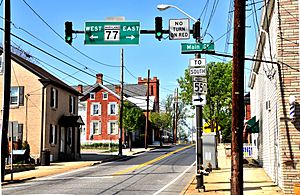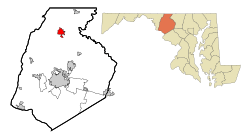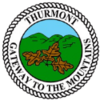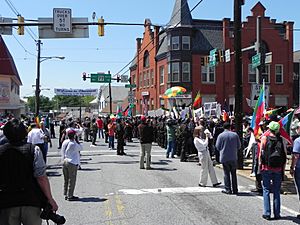Thurmont, Maryland facts for kids
Quick facts for kids
Thurmont, Maryland
|
|||
|---|---|---|---|
| Town of Thurmont | |||

Corner of Main and Water in downtown Thurmont.
|
|||
|
|||
| Motto(s):
"...Gateway to the Mountains"
|
|||

Location of Thurmont, Maryland
|
|||
| Country | |||
| State | |||
| County | |||
| Founded | 1751 | ||
| Incorporated | 1831 (as Mechanicstown), 1894 (as Thurmont) | ||
| Area | |||
| • Total | 3.12 sq mi (8.08 km2) | ||
| • Land | 3.11 sq mi (8.05 km2) | ||
| • Water | 0.01 sq mi (0.03 km2) | ||
| Elevation | 482 ft (147 m) | ||
| Population
(2020)
|
|||
| • Total | 6,213 | ||
| • Density | 1,999.68/sq mi (772.12/km2) | ||
| Time zone | UTC−5 (Eastern (EST)) | ||
| • Summer (DST) | UTC−4 (EDT) | ||
| ZIP Code |
21788
|
||
| Area code(s) | 301, 240 | ||
| FIPS code | 24-77825 | ||
| GNIS feature ID | 2391445 | ||
Thurmont is a town in Frederick County, Maryland, in the United States. In 2020, about 6,935 people lived there. It's in the northern part of Frederick County, not far from the Pennsylvania border, right along U.S. Highway 15.
Thurmont is close to fun places like Cunningham Falls State Park and Catoctin Mountain Park. Catoctin Mountain Park is special because it's home to Camp David, a quiet place where presidents go to relax. Every autumn, Thurmont hosts the Catoctin Colorfest, a huge arts and crafts festival that brings in around 125,000 visitors!
In 2005, Thurmont was recognized as a 'Maryland Main Street Community.' This means it was part of a program to help improve and preserve its historic downtown area. It also became a 'National Main Street' under the National Trust for Historic Preservation.
Contents
History of Thurmont
Thurmont was first started in 1751. It was originally called Mechanicstown.
Why the Name Changed
The town's name was changed to Thurmont on January 18, 1894. This happened because there were other towns nearby with similar names. For example, there was Mechanicsburg, Pennsylvania and Mechanicsville, Maryland.
Charles E. Cassell, who was the editor of the local newspaper called Catoctin Clarion, suggested the new name. He encouraged people to talk about the name change in his newspaper. Some of the names considered were Beaufort, Eastmont, Glenmont, and Blue Point.
Eventually, the choices came down to two main names: Thurmont, suggested by Cassell, and Blue Mountain City. Charles Shipley, a local real estate broker, thought Blue Mountain City was a good name. He said it was "appropriate" and "pretty" at a town meeting in December 1893.
The Clarion newspaper wrote about the old name, saying it was "harshness long drawn out." They felt it was time for a change.
By the end of December 1893, after several votes, Thurmont was chosen as the new name. The Post Office Department said they would not approve 'Blue Mountain City' because there was already a 'Blue Mountain' office in the state. This likely helped Thurmont win the vote.
The name Thurmont comes from two words. Thur is a German word meaning "gateway" or "entrance." Mons is a Latin word for "mountain." So, Thurmont roughly means "Gateway to the Mountains."
Railroads and Accidents
The Western Maryland Railway built its main railroad through Thurmont. This connected the town to Baltimore, and later to Hagerstown and Cumberland.
On June 17, 1905, a sad event happened. Sixteen men from Thurmont died in a train wreck in Ransom, Maryland. A freight train crashed head-on with another train. All businesses in Thurmont closed the next Monday. This accident had a lasting impact on the whole community.
Another big train accident happened on June 25, 1915. The Blue Mountain Express train hit another train head-on just west of Thurmont. Six people were killed. Charles Eyler, who was 17 at the time, remembered that people wondered how the engines stayed on the tracks. He said it was easy to see how the crash happened because the bridge was "blind" from both directions.
Geography and Climate
Thurmont is located at the eastern base of the Catoctin part of the Blue Ridge Mountains.
The town covers about 3.13 square miles (8.08 square kilometers). Most of this area is land, with a very small amount of water.
Thurmont's Climate
The weather in Thurmont has hot, humid summers. Winters are usually mild to cool. According to the Köppen Climate Classification system, Thurmont has a humid subtropical climate. This means it gets plenty of rain and has warm temperatures for much of the year.
Population and People
| Historical population | |||
|---|---|---|---|
| Census | Pop. | %± | |
| 1870 | 583 | — | |
| 1880 | 730 | 25.2% | |
| 1890 | 930 | 27.4% | |
| 1900 | 868 | −6.7% | |
| 1910 | 903 | 4.0% | |
| 1920 | 1,074 | 18.9% | |
| 1930 | 1,185 | 10.3% | |
| 1940 | 1,307 | 10.3% | |
| 1950 | 1,676 | 28.2% | |
| 1960 | 1,998 | 19.2% | |
| 1970 | 2,359 | 18.1% | |
| 1980 | 2,934 | 24.4% | |
| 1990 | 3,398 | 15.8% | |
| 2000 | 5,588 | 64.4% | |
| 2010 | 6,170 | 10.4% | |
| 2020 | 6,213 | 0.7% | |
| U.S. Decennial Census | |||
In 2010, there were 6,170 people living in Thurmont. There were 2,354 households, and 1,701 families. The town had about 1977.6 people per square mile.
Most of the people in Thurmont were White (95.8%). There were also smaller groups of Black, Native American, and Asian people. About 2.4% of the population was Hispanic or Latino.
About 36.7% of households had children under 18 living with them. Most households (56.9%) were married couples living together. The average household had 2.62 people, and the average family had 3.08 people.
The average age in Thurmont was 39.5 years old. About 25.8% of residents were under 18.
Getting Around Thurmont
The main way to travel to and from Thurmont is by road. U.S. Route 15 is the main highway. It connects Thurmont north to Gettysburg, Pennsylvania, and south to Frederick.
Maryland Route 806 follows parts of the old US 15 road through the center of Thurmont. The main highway now goes around the west side of town. Maryland Route 77 is the main east-west highway. It connects Thurmont east towards Keymar and west towards Smithsburg. MD 77 also helps people get to Catoctin Mountain Park.
Another highway, Maryland Route 550, goes northwest towards Fort Ritchie and southeast to Woodsboro.
Famous People from Thurmont
- Richard Troxell, an opera singer
- Neal Coty, a country music singer
See also
 In Spanish: Thurmont (Maryland) para niños
In Spanish: Thurmont (Maryland) para niños




